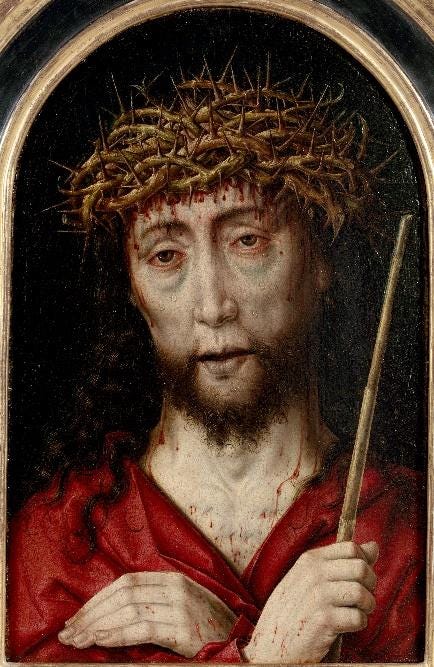Ecce Homo - A Genre of Devotional Art Inspired by Thomas a Kempis's Imitation of Christ
A commentary on a painting from the House of Leiden collection, Leiden, Holland
Albrecht Bouts (Leuven 1451/55 – 1549 Leuven), and studio
'Behold the Man', c. 1500; Oil on panel (41.8 x 27.1 cm)
'Jesus then came out wearing the crown of thorns and the purple robe. Pilate said, "Here is the man."'1
This painting of Christ's Passion relates to the quoted passage from John's Gospel. Pontius Pilate presented the brutally scourged Christ to the crowd with the words in Latin 'Ecce Homo', translated variously as 'Here is the Man' or 'Behold the Man'.
We see the crown of thorns, which pierces his flesh brutally, drawing blood, the 'purple' robe, and the reed sceptre he holds in his right hand. These were intended as symbols of mockery but point to the fact that the one mocked as a false king is, in truth, the King of Kings.2 Purple is the colour of royalty in the Roman society of the time. However, the artist here has shown the robe as red, not purple, indicating that it is drenched in the blood of the Saviour. Christ's facial expression is one of extreme fatigue, communicated by his pallor and drooping lids. Blood and tears run down his face, indicating both physical and spiritual suffering.
During the late Middle Ages and Renaissance, the Ecce Homo was used in private devotional prayer. It was connected to the rise of personal piety movements such as the Devotio Moderna (Modern Devotion), which began in Holland in the late fourteenth century. The Devotio Moderna emphasised a personal relationship with God and meditation, cultivating an intimate, affective relationship with Christ. In this approach, the emotions are channelled so that the person is led along a path into the contemplation of God. Ecce Homo images were used as aids to their meditation. By relating to his humanity in this way, we draw closer to the person of Christ and, hence, to his divinity, as Christ is both fully man and fully God.
The desire to convey emotion in art is facilitated by greater naturalism in the subject's rendition and the chosen medium. Oil paint, the medium chosen, allows for a greater degree of naturalism in the rendition of the subject because of the ease with which colours and tones can be blended smoothly. Other media, such as egg tempera, which would have been a common choice 100 years earlier, tend to produce flat, highly stylised paintings. This stylized rendition can be desirable, too, incidentally, for other reasons, and egg tempera is still the medium of Byzantine iconography.
We see the artist making use of the properties of oil paint in the murky, oily black background, using multiple thin glazes of paint, which contrasts with the light tone of Christ's skin, perhaps alluding to the spiritual darkness that surrounds this moment and the infinite depths of evil he will soon confront in his descent into Hades.⁵
The Devotio Moderna died out around the time of the Reformation. According to scholars, it was a movement that emphasized an individual approach to God, and at times given to an excess that placed private devotion above participation in the liturgy and, hence, the sacramental life of the Church.3 The Catholic Church has always maintained a balance between liturgical prayer and private prayer, placing particular emphasis on communal and sacramental prayer—especially the Liturgy of the Hours and the Mass—seeking to make them the source that nourishes and inspires personal and existential prayer4. . With this caution in mind, we can meditate upon the Ecce Homo and simultaneously ponder over the words of scripture or spiritual writing to great benefit.
The following words are taken from The Imitation of Christ, a devotional book of spiritual exercises commonly believed to reflect the spirituality of the Devotio Moderna. It was written in the 15th century and is attributed to a German priest, Thomas à Kempis. It immediately became a bestseller and is still published and read widely today.
In Book 2, Chapter 2, on humility, Thomas explains how we can experience joy even in suffering. He says:
'If you know how to suffer in silence, you will undoubtedly experience God's help. He knows when and how to deliver you; therefore, place yourself in His hands, for it is a divine prerogative to help men and free them from all distress.'
Footnotes:
1 John 19:5.
2 1 Timothy 6:15.
3 Cf B. Henderiks, Albrecht Bouts (1451/55-1549) (Brussels: IRPA/KIK, 2009), p. 164; and K. Veelenturf, 'Modern Devotion and Late Medieval Art', in Late Medieval Netherlandish Art and Visual Culture, ed. by W.S. Gibson (New York: Brill, 2000), pp. 101-126. [using the reference to Devotio Moderna and connection to this imagery from the the first commentary by Yvette, DC]
4. Cf Catechism of the Catholic Church, 1324; Cf Second Vatican Council, Constitution on Sacred Liturgy, Sacrosanctum Concilium, 1963, para 10 <https://www.vatican.va/archive/hist_councils/ii_vatican_council/documents/vat-ii_const_19631204_sacrosanctum-concilium_en.html> [Accessed Dec 31 2024]





Thank you. I don't know offhand, but it seems that the sentiment is very similar doesn't it.
Fascinating commentary. Do you think this genre grew out of the Man of Sorrows iconography?